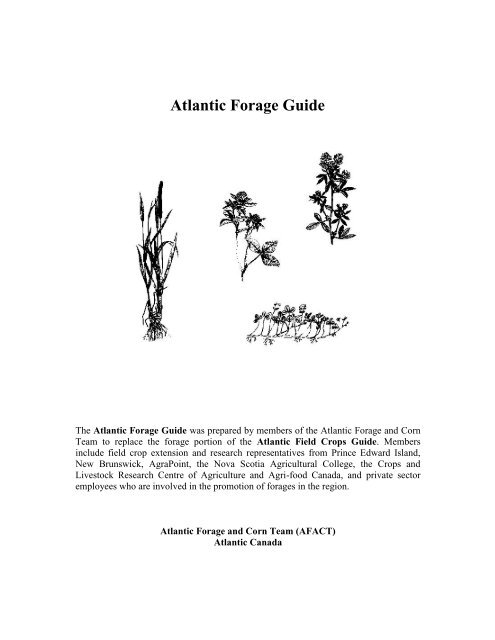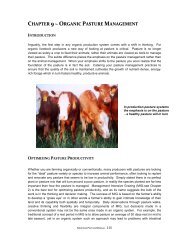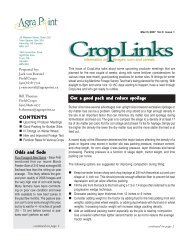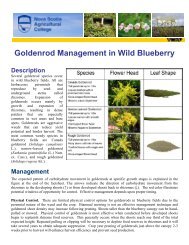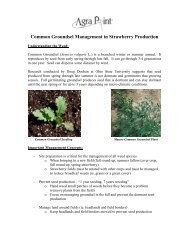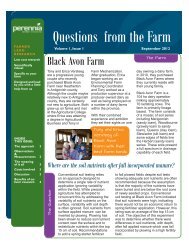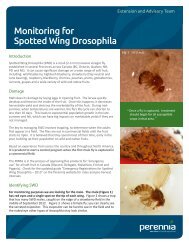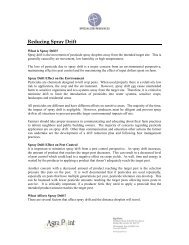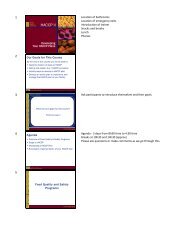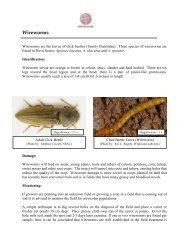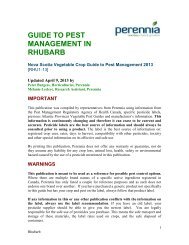You also want an ePaper? Increase the reach of your titles
YUMPU automatically turns print PDFs into web optimized ePapers that Google loves.
<strong>Atlantic</strong> <strong>Forage</strong> <strong>Guide</strong><br />
The <strong>Atlantic</strong> <strong>Forage</strong> <strong>Guide</strong> was prepared by members of the <strong>Atlantic</strong> <strong>Forage</strong> and Corn<br />
Team to replace the forage portion of the <strong>Atlantic</strong> Field Crops <strong>Guide</strong>. Members<br />
include field crop extension and research representatives from Prince Edward Island,<br />
New Brunswick, AgraPoint, the Nova Scotia Agricultural College, the Crops and<br />
Livestock Research Centre of Agriculture and Agri-food Canada, and private sector<br />
employees who are involved in the promotion of forages in the region.<br />
<strong>Atlantic</strong> <strong>Forage</strong> and Corn Team (AFACT)<br />
<strong>Atlantic</strong> Canada
Table of Contents<br />
INTRODUCTION ........................................................................................................................................................ 4<br />
FORAGE ESTABLISHMENT ..................................................................................................................................... 4<br />
Seedbed preparation ........................................................................................................................................ 4<br />
Inoculation of legumes ................................................................................................................................... 4<br />
Coated seed ..................................................................................................................................................... 5<br />
Seeding method .............................................................................................................................................. 5<br />
Direct seeding ................................................................................................................................................. 5<br />
Underseeding/cover crops/companion crops .................................................................................................. 6<br />
WEED CONTROL ........................................................................................................................................................ 6<br />
Mechanical weed control ................................................................................................................................. 7<br />
Cultural weed control ...................................................................................................................................... 7<br />
Biological weed control................................................................................................................................... 7<br />
Chemical weed control .................................................................................................................................... 7<br />
FERTILIZING FORAGES ........................................................................................................................................... 7<br />
Fertilizing in the seeding year ........................................................................................................................ 8<br />
Fertilizing established stands ........................................................................................................................ 10<br />
Fertilizing pastures ........................................................................................................................................ 12<br />
COMMON INSECT PESTS ...................................................................................................................................... 12<br />
European skipper ........................................................................................................................................... 12<br />
Alfalfa blotch leafminer ................................................................................................................................ 13<br />
Armyworm .................................................................................................................................................... 13<br />
COMMON DISEASES .............................................................................................................................................. 14<br />
Legume diseases ............................................................................................................................................ 14<br />
Grass diseases ................................................................................................................................................ 14<br />
CROP MANAGEMENT ............................................................................................................................................. 15<br />
Harvest management ..................................................................................................................................... 15<br />
Fall management .......................................................................................................................................... 16<br />
Pasture management ..................................................................................................................................... 16<br />
<strong>Forage</strong>s for soil improvement ....................................................................................................................... 17<br />
PERENNIAL FORAGE SPECIES ............................................................................................................................. 18<br />
Choosing a mixture ....................................................................................................................................... 18<br />
Red clover ..................................................................................................................................................... 18<br />
Alfalfa 19<br />
White clover .................................................................................................................................................. 19<br />
Birdsfoot trefoil ............................................................................................................................................. 20<br />
Alsike clover ................................................................................................................................................. 20<br />
Sweet clover…… .......................................................................................................................................... 21<br />
Timothy 21<br />
Smooth bromegrass ....................................................................................................................................... 21<br />
2
Meadow bromegrass ..................................................................................................................................... 22<br />
Orchardgrass.................................................................................................................................................. 22<br />
Meadow fescue .............................................................................................................................................. 22<br />
<strong>Perennia</strong>l ryegrass ......................................................................................................................................... 22<br />
Reed canarygrass ........................................................................................................................................... 23<br />
Tall fescue ..................................................................................................................................................... 23<br />
Kentucky bluegrass ....................................................................................................................................... 23<br />
Creeping red fescue ....................................................................................................................................... 24<br />
ANNUAL FORAGE CROPS ..................................................................................................................................... 24<br />
Persian clover ................................................................................................................................................ 24<br />
Berseem clover .............................................................................................................................................. 25<br />
Italian and Westerwolds ryegrass .................................................................................................................. 25<br />
Cereals… ....................................................................................................................................................... 25<br />
Green fodder crops ........................................................................................................................................ 26<br />
Kale 26<br />
<strong>Forage</strong> rape .................................................................................................................................................. .26<br />
Stubble turnips............................................................................................................................................... 26<br />
Fodder beets .................................................................................................................................................. 27<br />
List of Tables<br />
Table 1. Sensitivity of forage species to soil<br />
acidity……………………………………………………………………8<br />
Table 2. Recommended fertilization for forages in the seeding year (broadcast-seeded forage, sown alone or with<br />
companion cereals)...................................................................................................…………………………9<br />
Table 3. Average dry matter and nutrient concentration of manures on Nova Scotia<br />
farms.........................................10<br />
Table 4. Fertilization of established forage stands.......................................................................................................11<br />
Table 5. Average optimum dates for first cuts of forage grasses and legumes in production.......................................15<br />
Table 6. Root mass of grasses and legumes in the top 15 cm of soil in the seeding year, Charlottetown,<br />
PEI.............17<br />
3
INTRODUCTION<br />
<strong>Forage</strong> production is an important component of livestock enterprises as high-quality feed must<br />
be available year-round. As no single forage species or mixture can supply the total requirements<br />
for livestock, a comprehensive plan is required for each particular livestock operation.<br />
Management plans must consider the type of livestock and the size of the operation, as well as<br />
factors of land type and availability, labour, storage methods, available capital, equipment, time<br />
of year the forage is required, and producer preferences. On most farms forage programs<br />
incorporate several perennial species for hay or silage, pasture, and zero-graze; annual species<br />
are also used occasionally. <strong>Forage</strong> crops must be managed as intensively as other high-yielding<br />
crops with consideration given to climate, soil, and end use of the forage. Management practices<br />
include variety selection, fertilization, pest control, time and frequency of cut, and appropriate<br />
fall rest period.<br />
FORAGE ESTABLISHMENT<br />
<strong>Perennia</strong>l forage plants must develop sufficient size and root reserves to survive winter<br />
temperatures and regrow the following spring; only the most winterhardy grasses, such as<br />
timothy and bromegrass, can be planted in late August or early September. Legume/grass<br />
perennial mixtures are best established from late April to mid-May and should provide 2 to 3 t/ha<br />
of dry matter in the seeding year and have sufficient development to overwinter well.<br />
Seedbed preparation<br />
Small-seeded legumes and grasses require a fine, firm seedbed for uniform planting depth and<br />
good germination. Overworking the soil or using large tillage equipment may result in a loose<br />
seedbed that will need to be firmed sufficiently with a cultipacker-type seeder or roller before<br />
seeding. The seedbed can also be firmed by a land leveller or roller harrow. Working the soils too<br />
early when the soil is wet can lead to crusting, water logging, and poor emergence of legumes<br />
and grasses.<br />
Inoculation of legumes<br />
Legume seed must be inoculated with an appropriate Rhizobium inoculant before planting.<br />
Inoculants contain bacteria which form nodules on the roots of legumes to fix nitrogen from the<br />
4
air. Pre-inoculated seed is available but it is important to check the expiry date. Commerciallyavailable<br />
inoculants contain live bacteria and should be stored in a cool dark place. Check the<br />
expiry date on the packet before applying and follow the instructions carefully. Pre-inoculated<br />
seed that has been stored over winter should be re-inoculated to ensure that viable bacteria are on<br />
each seed at planting.<br />
Coated seed<br />
Coated seed is used in forage stands to improve seedling emergence and establishment. It may<br />
also be beneficial in reintroducing legumes into pastures or hay fields, particularly in situations<br />
where tillage is limited. Various combinations of inoculating bacteria, lime, nutrients, and<br />
bonding agents are used in the coatings. Although the effectiveness of inoculation can be<br />
improved by using coated seed, this is usually not necessary. Coated seed from previous years<br />
should be re-inoculated to ensure the presence of live bacteria in the year of seeding.<br />
Because coated seeds are larger than uncoated ones, a kilogram of coated seed contains fewer<br />
seeds than a kilogram of uncoated seed; seeder settings may need to be adjusted accordingly.<br />
Seeding method<br />
Small forage seeds should be distributed uniformly and covered with 1 cm of soil. If the soil is<br />
extremely dry, a slightly deeper placement into moist soil is recommended. Either a drill or<br />
cultipacker seeder (e.g., Brillion) may be used. Cultipacker seeders place the seed uniformly in<br />
the upper 1 cm of soil and firm the seedbed immediately after planting. With many grain drills,<br />
seed tubes can be attached to the drill so that the seeds are placed directly behind the disc openers<br />
for shallow forage seed placement. It is recommended that the field be rolled following drilled<br />
seeding.<br />
Direct seeding<br />
New forage crops can be established without a companion or cover crop. <strong>Forage</strong> seeded without<br />
a companion crop will normally yield one cut in the first year; yield doubles in the first<br />
production year. Under good conditions, alfalfa planted in late April or early May can be<br />
harvested in July and once more before the recommended last harvest date. Adequate fertility,<br />
5
especially phosphorous, is important for direct-seeded stands. If a grain drill is equipped with<br />
fertilizer boxes, forage establishment may be improved with banded phosphorous.<br />
Underseeding/cover crops/companion crops<br />
Underseeding forage with a cereal companion crop is a traditional practice for many farmers in<br />
the <strong>Atlantic</strong> region. When successful, underseeding can reduce erosion and limit weed growth.<br />
Harvesting cereal crops early for silage can improve forage seedling growth and establishment.<br />
With good weed control, the cereal companion crop can also be harvested for grain if the<br />
combining occurs early enough for the forage crop to develop properly before winter.<br />
There is always the potential for cereal crops to out-compete forages for sunlight, nutrients, and<br />
water. As a result, grass and legume seedlings may die or not be vigorous enough to develop into<br />
strong stands. Competition from companion crops and the late removal of straw are two common<br />
reasons for poor forage stand establishment. Red clover, orchardgrass, and ryegrasses are better<br />
suited for underseeding than alfalfa and timothy.<br />
WEED CONTROL<br />
Weed control limits weed growth and invasion to allow efficient and profitable forage<br />
production. An efficient weed control program should reduce the weed population to a level that<br />
is not economically damaging; total weed eradication (non-noxious) is expensive and not<br />
necessary for forage production. The first step of a good weed control program is to identify the<br />
type and quantity of weeds present in the forage crop before harvest. Weeds should be classified<br />
as annuals or perennials and both grasses and broadleaf weeds should be included. The severity<br />
of infestation should be noted as being rare, scattered, occasional, common and/or abundant. This<br />
assessment should be done annually to evaluate the current weed control program and to make<br />
adjustments for the following year.<br />
Types of control generally fall into four main categories: mechanical or physical, cultural or<br />
management, biological, and chemical. The main factors to consider when selecting a weed<br />
control program are the type of stand to be treated (seeded or established), weed type, and weed<br />
density.<br />
6
Mechanical weed control<br />
Mechanical weed control is most effective in newly-seeded forage stands. Fields are clipped in<br />
late June or early July to remove weed flowers and to allow the forage to grow. This practice<br />
controls many annual weeds but is not effective against perennial weeds, such as quackgrass or<br />
dandelion. Many perennial weeds can be controlled on a short-term basis by plowing, discing,<br />
and reseeding. For weeds with rhizomes, such as quackgrass, a chemical weed control method is<br />
more effective.<br />
Cultural weed control<br />
Cultural weed control concentrates on management practices that improve crop growth; a<br />
vigorous forage crop will be better able to out-compete weeds. Choose a well-adapted forage<br />
variety, lime and fertilize according to soil-test recommendations, plant as early as possible, and<br />
practise good grazing and cutting management.<br />
Biological weed control<br />
Biological weed control introduces specific diseases or insects to target a particular type of weed.<br />
Insects have been particularly effective; for example, the cinnabar moth was successfully<br />
introduced to control tansy ragwort. For more information on the cinnabar moth and other<br />
biological control programs, contact the Nova Scotia Agricultural College.<br />
Chemical weed control<br />
Chemical weed control methods involve the use of herbicides to inhibit weed growth. Herbicides<br />
are specific to weed type and should be applied only according to label specifications. The<br />
timing, method, and amount of the application depend on the stage of crop growth and weed<br />
development. Herbicides should be used in combination with other weed control methods and in<br />
conjunction with sound crop management practices. For more information, consult OMAFRA<br />
Publication 75, <strong>Guide</strong> to Weed Control.<br />
FERTILIZING FORAGES<br />
<strong>Forage</strong> crops require large applications of nutrients for high yields. When combined with good<br />
7
crop management, the application of fertilizer and lime according to soil-test recommendations<br />
will maximize the economic yield of forage crops. To maintain productivity, a soil test should be<br />
taken every two to three years. If legumes make up 60% or more of the forage stand, a boron test<br />
should also be taken. Testing for low levels of soil micronutrients may also be appropriate.<br />
Liming the soil can reduce fertilizer costs and increase yields; forage yields almost double when<br />
appropriate fertilizer is applied to a soil with a pH of 6.2 as compared with an acidic soil with a<br />
pH of less than 5.4.<br />
Fertilizing in the seeding year<br />
Always apply lime and fertilizer according to soil-test recommendations. Limestone should be<br />
applied in the fall before seeding and worked into the soil to raise the pH to required levels.<br />
<strong>Forage</strong> species differ in their sensitivity to soil pH (Table 1). If your soil needs magnesium, use<br />
dolomitic limestone. The need for magnesium is dependent on soil calcium and potassium levels.<br />
Consult with your nutrient management planner.<br />
Table 1. Sensitivity of forage species to soil acidity<br />
Sensitive<br />
Low tolerance<br />
keep soil pH near 6.5 keep soil pH 6.0–6.5<br />
Moderate tolerance<br />
keep soil pH above 5.8<br />
Alfalfa Kentucky bluegrass Alsike clover<br />
Smooth bromegrass White clover Birdsfoot trefoil<br />
Sweet clover Orchardgrass Meadow fescue<br />
Red clover<br />
Ryegrasses<br />
Timothy<br />
Redtop<br />
Reed canarygrass<br />
Tall fescue<br />
General guidelines for fertilizing forages in the seeding year are provided in Table 2.<br />
Phosphorous is very important for good root development and seedling establishment. Starter<br />
nitrogen is required by all forage seedlings including legumes until they become nodulated and<br />
can fix their own nitrogen. <strong>Forage</strong> crops use more potassium than any other element. Potassium<br />
helps plants to resist disease, insects, and drought while improving cold hardiness and sugar<br />
transport.<br />
8
Table 2. Recommended fertilization for forages in the seeding year (broadcast-seeded<br />
forage, sown alone or with companion cereals)<br />
Time<br />
Nutrients<br />
(kg/ha)<br />
N P2O5 K2O<br />
Example<br />
analysis<br />
Application<br />
(kg/ha)<br />
Before seeding z 15–25 60–120 60–120 5-20-20 300–500<br />
After clipping or 1st harvest<br />
Legume-dominant swards<br />
Grass-dominant swards<br />
0<br />
35–55 15–20<br />
90<br />
35–55<br />
0-0-60<br />
18-6-18<br />
150<br />
200–300<br />
z For band seeding, broadcast half of the fertilizer before seeding and apply the other half in a band. Use the higher<br />
application in fields that have been infrequently fertilized and/or limed.<br />
Boron should be applied to legumes in the seeding year according to soil-test analysis. Excess<br />
boron can retard or even kill forage seedlings. For alfalfa crops, a soil test for boron should be<br />
taken every two to three years. Soil boron levels under 1 ppm indicate an application is needed.<br />
<strong>Forage</strong> crops may also be deficient in other micronutrients, including zinc (see Crop<br />
Micronutrients in <strong>Atlantic</strong> Canada, Publ. 537-86).<br />
Manure is a good source of organic matter and nutrients and its use can substantially reduce the<br />
amount of commercial fertilizer required. For maximum benefits, manure should be applied<br />
before seeding in the spring and worked into the soil. See Table 3 for information on manure<br />
nutrient values.<br />
9
Table 3. Average dry matter and nutrient concentration of manures on Nova Scotia<br />
farms<br />
Manure type Consistency<br />
Dry matter<br />
(kg/t)<br />
Total N<br />
(kg/t)<br />
Ammonium N<br />
(kg/t)<br />
P2O5<br />
(kg/t)<br />
K2O<br />
(kg/t)<br />
Dairy Liquid 88 3.1 1.5 1.6 3.4<br />
Semi-solid 157 4.4 1.8 2.5 4.7<br />
Solid 218 5.0 1.5 3.0 5.8<br />
Beef Semi-solid 126 2.7 0.8 1.2 3.8<br />
Solid 214 4.4 1.0 2.2 5.3<br />
Swine Liquid 53 2.5 1.7 1.9 1.1<br />
Semi-solid 152 5.3 2.4 5.0 2.2<br />
Solid 240 7.6 3.0 4.7 5.4<br />
Poultry Liquid 171 7.7 4.1 5.4 3.1<br />
Semi-solid 318 15.2 6.6 13.5 7.0<br />
Solid 706 33.9 8.4 25.1 15.9<br />
Modified from Brenton and Mellish (1996).<br />
Fertilizing established stands<br />
Without adequate fertilization, forage stands will thin out and revert back to less productive<br />
native swards. A balanced fertility program is necessary to ensure the longevity of the tame<br />
species (see Table 4).<br />
10
Table 4. Fertilization of established forage stands<br />
Nutrients<br />
(kg/ha)<br />
Example<br />
analysis<br />
Rate<br />
(kg/ha)<br />
Timing for typical stands<br />
N P2O5 K2O<br />
Harvest for silage or hay<br />
Over 60% legumes<br />
-Spring, growth starts 20 0–60 60 10-10-30 200<br />
-After 2 nd or 3 rd cut 0 0 90–120 0-0-60 150–200<br />
30–60% legumes<br />
-Spring, growth starts 50 0–60 0–100 21-6-18 250<br />
-After cut 1 50 0 0 34-0-0 150<br />
Over 70% grass<br />
-Spring, growth starts 75 0–60 0–100 21-6-18 350<br />
-After cut 1 50–70 0 0 34-0-0 150–200<br />
Pasture<br />
Over 60% legumes<br />
-Mid-June, late July, early Sept. 20 0–60 0–60 10-20-20 200<br />
30–60% legumes<br />
-early spring, mid-June, late July, early<br />
Sept.<br />
30 10 25 21-6-18 150<br />
Over 70% grasses<br />
-Late April, early May 35–50 0–60 0–60 21-6-18 250<br />
-mid-June, mid-August 35–40 0 0 34-0-0 100–125<br />
To maintain hay and silage stands, follow these five recommendations:<br />
• Fertilize annually with potassium according to soil-test recommendations.<br />
• In the seeding year, make sure to apply sufficient amounts of phosphorus. A small amount<br />
is required annually for production years.<br />
• Nitrogen is required for pure grass stands or mixtures that have less than 60% legumes.<br />
Apply fertilizer containing nitrogen in early spring and again after each cut. Several kinds of<br />
nitrogen fertilizer are available. A urea-based nitrogen fertilizer can be used for spring/first<br />
cut applications. Less volatile types of nitrogen fertilizer, such as those containing ammonium<br />
nitrate or calcium ammonium nitrate, are recommended when there is a high potential for loss<br />
by evaporation (late June to late August). Fertilizer should be applied at least four to five<br />
weeks before harvest to ensure that protein is properly converted by plants.<br />
• When manure is applied, reduce chemical fertilization accordingly (Table 3).<br />
11
• When older grass swards lose productivity, it may be more economical to reseed with a<br />
legume or legume/grass mixture than to continue with high applications of nitrogen.<br />
Fertilizing pastures<br />
<strong>Forage</strong>s used for pasture have similar nutrient requirements as those grown for hay or silage.<br />
However, in well-managed pastures many nutrients can be supplied by grazing animals in the<br />
form of manure and urine. Commercial fertilizer can be used to stimulate early growth. A regular<br />
soil-testing schedule can monitor the nutrient levels of individual fields so that fertility<br />
applications are customized and cost-effective. Along with Table 4, the following points will help<br />
in developing your own individual fertility program.<br />
• The timing of fertilizer applications, particularly nitrogen, can greatly influence pasture<br />
growth. An early spring application of nitrate fertilizer stimulates growth while soil<br />
temperatures are low and the soil bacteria that release and convert nitrogen to the nitrate form<br />
are not yet active. Intensively-managed pastures produce high yields, particularly early in the<br />
season; it is usually necessary to harvest some of the forage as hay or silage.<br />
• For many grass pastures, a split application of nitrogen is more efficient and will result in<br />
better grass growth. Applications should be balanced to help protect the health of grazing<br />
animals.<br />
• When grasses are heavily fertilized, especially with potassium in early spring, use<br />
dolomitic limestone to minimize the incidence of hypomagnesaemia (grass tetany) in grazing<br />
stock.<br />
• If large amounts of potassium are required, splitting the application may help to prevent<br />
grass tetany by producing forage with a good balance of potassium and magnesium.<br />
• In some cases, supplemental applications of phosphorus may be needed, especially to<br />
encourage white clover growth.<br />
COMMON INSECT PESTS<br />
European skipper<br />
The European skipper is common throughout the <strong>Atlantic</strong> Provinces and heavy infestations can<br />
substantially reduce timothy yields. Adult butterflies are orange-brown in colour with a 3-cm<br />
wing spread. They tend to congregate in damp places and can be found in hayfields by<br />
12
midsummer. The larvae are light green and the caterpillars can grow up to 2 cm in length. They<br />
feed off of timothy leaves, leaving the leaf margins irregularly notched. When larvae are<br />
abundant they can defoliate timothy and other grasses, including orchardgrass, perennial<br />
ryegrass, and meadow fescue. European skippers will also feed on leguminous plants when other<br />
food is scarce.<br />
Fields should be checked for caterpillars in late May or early June, when leaves are first rolled<br />
into tubes. The field should be treated with insecticides if damage was extensive in the previous<br />
year or if there are 65 or more caterpillars per square meter. Early cutting can reduce the damage<br />
in some years and cutting hay before mid-June should help prevent pest build-up. In Prince<br />
Edward Island, a virus has been introduced to help control the European skipper.<br />
Alfalfa blotch leafminer<br />
Alfalfa blotch leafminer can be found in most alfalfa-growing areas. The adult leafminer is a<br />
small black fly which emerges in late May. It is best identified by the numerous pinhole<br />
punctures it makes in alfalfa leaflets when it feeds and lays eggs. The affected leaflets frequently<br />
shatter and the heavy pinhole damage causes necrosis in parts of the leaflets as well as nutritional<br />
loss. After the eggs hatch, the developing maggots or miners feed inside the leaflets, eating away<br />
the central part and creating mines or tunnels that terminate in blotches. The maggots then drop to<br />
the soil and pupate. The insect’s life cycle is about a month; in the <strong>Atlantic</strong> region there are three<br />
generations per growing season.<br />
Damage may be reduced in the first crop by early cutting but later cutting dates do not correspond<br />
to subsequent infestations. Introduced and native parasites of the leafminer have been successful<br />
at controlling this pest. Chemical control is not recommended.<br />
Armyworm<br />
Localized armyworm outbreaks can occur periodically in the <strong>Atlantic</strong> Provinces. Maintain a close<br />
watch in late June and July, especially in grass fields. Examine crops just before sunset when<br />
caterpillars are most visible. Control methods include cutting the crop immediately or applying<br />
pesticides. Read product labels carefully because chemical control methods can limit forage use.<br />
13
COMMON DISEASES<br />
All forage legumes and grasses grown in the <strong>Atlantic</strong> region are susceptible to disease. Disease<br />
prevalence depends on many factors, including the presence of sources of infection and<br />
favourable temperature and moisture conditions.<br />
Legume diseases<br />
Many diseases affect more than one forage legume crop. In the <strong>Atlantic</strong> region, root and crown<br />
rots, common leaf spot, black stem, downy mildew, powdery mildew, northern anthracnose,<br />
sooty blotch, clover phyllody, and nematode diseases have been identified in a variety of<br />
legumes.<br />
Verticillium wilt of alfalfa has been identified throughout <strong>Atlantic</strong> Canada. Verticillium wilt is a<br />
serious disease because it can reduce alfalfa plant populations to the extent that forage quality and<br />
quantity is severely affected. Verticillium wilt is spread by sowing contaminated seed or by<br />
carrying infected plant parts from one field to another on harvesting equipment. Long-term<br />
control can be achieved by using alfalfa cultivars that show resistance to the effects of the<br />
verticillium organism. Highly-resistant cultivars recommended for use in the <strong>Atlantic</strong> Provinces<br />
are provided in the annual, <strong>Forage</strong> <strong>Guide</strong> to Variety & Mixture Selection.<br />
Grass diseases<br />
Common diseases that affect <strong>Atlantic</strong> forage crops include leaf rust brown stripe, eyespot, and<br />
brown spot. Each disease is caused by a different organism. Symptoms include decaying roots,<br />
spots on the stems and leaves, and leaves replacing flower petals.<br />
Prevention is the best method of disease control; chemical control methods are seldom necessary.<br />
Good farm practices, such as using resistant or tolerant cultivars, crop rotation, and using early<br />
cutting management, will reduce the incidence of disease. In terms of farm management, delayed<br />
cutting is the factor most responsible in the build-up of disease.<br />
CROP MANAGEMENT<br />
Harvest management<br />
14
Harvesting should be timed to maximize forage yield and quality while ensuring long-term stand<br />
survival.<br />
Table 5. Average optimum dates for first cuts of forage grasses and legumes in<br />
production<br />
Very early Early Medium Late<br />
Climatic<br />
zone<br />
Orchardgrass,<br />
bromegrass,<br />
Kentucky<br />
bluegrass,<br />
reed canary,<br />
and fescues<br />
Most alfalfa,<br />
early timothy<br />
Later alfalfa,<br />
medium timothy,<br />
double-cut red clover<br />
Late timothy,<br />
single-cut<br />
red clover, and<br />
birdsfoot trefoil<br />
1 May 27–June 4 June 2–9 June 11–18 June 16–23<br />
2 June 9–16 June 14–21 June 19–26 June 23–30<br />
3 June 17–24 June 22–29 June 27–July 4 July 1–8<br />
4 June 25–July 2 June 30–July 7 July 5–12 July 9–16<br />
5 July 3 July 8 July 13 July 17<br />
For optimal quality, harvest forage crops when the legume portion is at the bud-to-10%-bloom<br />
stage (Table 5). Cutting at this stage will allow for up to three harvests per season before<br />
September 1 in some Maritime locations. Although the three-cut system does provide higher<br />
quality feed, harvest costs are higher and stand longevity may be affected.<br />
When the entire forage crop on a farm is planted to one crop or mixture, the crop must be cut<br />
within a week to ensure top-quality feed. Planting a range of species or cultivars can extend the<br />
harvesting period. Select legumes according to their maturity (see the annual <strong>Forage</strong> <strong>Guide</strong> to<br />
Variety & Mixture Selection) and match grass species and cultivars to the legume. When<br />
selecting legume and grass species, keep in mind the length of time it will take to harvest all the<br />
forages and consider the unique soil and climate conditions of each field.<br />
It is important to minimize forage legume leaf loss during harvest because approximately 70% of<br />
the plant’s total protein is found in the leaves. Three management methods that can reduce leaf<br />
loss are: cutting with mower-conditioners, tedding soon after cutting, and harvesting as silage.<br />
For hay crops high in legume content, leaf shattering can be reduced by raking at about 40%<br />
moisture content, baling at slightly higher moisture levels (i.e., 20–25% moisture), and using<br />
effective preservatives or barn dryers. To improve drying, windrow inverters can be used to move<br />
15
and invert windrows of nearly-dry forage with little leaf loss.<br />
Fall management<br />
In the fall, legumes and grasses accumulate and store food, as starch, in their roots during a<br />
period known as the ‘critical fall rest period’. High levels of reserves are needed for winter<br />
survival and spring growth. Cutting during the critical fall rest period can lower root reserves,<br />
weaken plants, and increase the chances of winterkill. To ensure stand longevity and vigorous<br />
spring growth, do not cut or graze perennial crops, including alfalfa, after the critical date<br />
recommended for your area. (Generally not after September 1 st in the <strong>Atlantic</strong> Provinces.)<br />
Pasture management<br />
Proper grazing management is critical to optimize forage yields, maximize the longevity of<br />
improved species, and maintain sward quality. Short periods of heavy grazing (one to five days)<br />
should be followed by a recovery period. The length of time required for pasture regrowth will<br />
vary from year to year but as a rough estimate the recovery period needed in midsummer<br />
(approximately 35 days) will be twice as long as that required in May or June (approximately 12–<br />
15 days).<br />
White clover and birdsfoot trefoil are particularly valuable feed components and pastures should<br />
be managed to ensure their long-term survival. Annual crops, such as kale, rape, stubble turnip,<br />
and ryegrass, can provide high-quality feed for grazing animals from mid to late season. When<br />
grazing these annual crops, livestock must have access to perennial pastures or hay to ensure<br />
adequate fibre intake, optimal health, and milk quality.<br />
Although recently-seeded pastures with improved forage species respond best to applied fertility,<br />
the yield of older permanent pastures can also be improved with additions of lime, fertilizer, or<br />
manure.<br />
Further information on pasture management and annual forage crops is available from local crop<br />
specialists.<br />
<strong>Forage</strong>s for soil improvement<br />
16
To maintain soil fertility, crops should be rotated regularly on all farmland. <strong>Forage</strong>s are an<br />
important crop to include in rotations because they improve soil structure, reduce soil erosion,<br />
break insect and disease cycles, and add organic matter to the soil. Legumes have the additional<br />
benefit of being able to fix soil nitrogen.<br />
Alfalfa grown with a grass is a good rotation crop that can provide long-term productive forage<br />
with good soil drainage and a soil pH of 6.0 or greater. Red clover, usually mixed with timothy<br />
and meadow fescue, is another good break or rotation crop, especially on soils unsuitable for<br />
alfalfa production.<br />
Italian and Westerwolds (annual) ryegrasses can control soil erosion, add organic matter, and<br />
improve soil structure. Annual ryegrasses are poor hosts for the root lesion nematode and are not<br />
hosts for clover and northern root knot nematodes; growing ryegrasses in rotation may alleviate<br />
these pest problems. Annual ryegrasses can also be direct seeded in the spring to provide pasture<br />
and/or silage. Italian type annual ryegrasses are best suited for pastures and ryegrass can be<br />
underseeded to cereal crops to provide a late-season pasture or cover crop. When silage is to be<br />
harvested, a Westerwolds ryegrass should be sown. For erosion control, annual ryegrasses can be<br />
sown up until early August, although dry soils may hinder seedling establishment.<br />
Table 6. Root mass of grasses and legumes in the top<br />
15 cm of soil in the seeding year, Charlottetown, PEI<br />
Dry root mass<br />
Species<br />
Cultivar<br />
(t/ha)<br />
Italian ryegrass Lemtal 64<br />
Italian ryegrass Maris Ledger 64<br />
Westerwolds ryegrass Promenade 64<br />
Westerwolds ryegrass Aubade 34<br />
Red clover 1.5–2.5<br />
Alfalfa 1.5–2.5<br />
Barley 1.0–1.5<br />
PERENNIAL FORAGE SPECIES<br />
Choosing a mixture<br />
A good forage program begins with selecting the legume and grass species that are best suited to<br />
17
local growing conditions. For the most recent variety and mixture recommendations, consult<br />
publication, <strong>Forage</strong> <strong>Guide</strong> to Variety & Mixture Selection. Simple mixtures, i.e., one legume<br />
species with one or two grass species, are often more productive than complex mixtures. In a<br />
complex mixture, the competitive strength of the species is often not related to forage yield, and<br />
competition from a low-yielding species can depress total stand yield. Mixtures with a high<br />
percentage of legumes are recommended only under optimum field conditions.<br />
The legume species should be chosen first; legumes contain more protein than grasses and have<br />
the ability to improve the soil by fixing nitrogen. Including legumes in a rotation improves soil<br />
structure, increases organic matter, and provides nitrogen for subsequent crops. When selecting a<br />
legume species, consider its intended use and winterhardiness. The desired longevity of the stand<br />
should also be taken into consideration as well as soil drainage. Soil fertility and pH can be<br />
altered to accommodate the requirements for an individual species. From the list of recommended<br />
mixtures, select those grass cultivars that will best complement the legume species.<br />
Red clover (Trifolium pratense)<br />
Red clover is a biennial or short-lived perennial that yields well in the first production year. It is<br />
more tolerant than alfalfa to low soil pH and variable drainage conditions. Because red clover is<br />
difficult to make into hay (see Harvest Management), it is more easily managed as silage.<br />
Timothy is the best grass to mix with red clover for stored feed. Red clover is not recommended<br />
in pasture mixtures because it is short-lived and does not tolerate close and frequent grazing. Red<br />
clover should not be included in alfalfa/grass mixtures because the strong competition with<br />
alfalfa during the seeding year will result in thin alfalfa stands.<br />
Double-cut and single-cut types of red clover are available. Double-cut red clover reaches the<br />
cutting stage about 10 days earlier than single-cut types and has a stronger, more vigorous<br />
regrowth. For growers looking to harvest one crop a season, single-cut red clover with a very late<br />
timothy (e.g., Farol) makes a suitable mixture for a delayed harvest in July; yield is high and<br />
quality is good. Red clover also makes an excellent plough-down or green manure crop. In a<br />
good year, direct seeding of red clover can produce a four tonne/hectare hay crop in late July and<br />
a further two tonnes each of top growth and roots by late fall.<br />
18
Alfalfa (Medicago sativa)<br />
Alfalfa is a high-yielding forage legume that produces nutritious feed. This legume should be<br />
grown in protected fields with good drainage. Soils should be high in nutrients with a pH of 6.3<br />
or greater. For best results, use seeds that have been treated with an inoculant that is specific to<br />
alfalfa.<br />
Alfalfa should be grown in a grass mixture. Including a grass in an alfalfa stand can reduce<br />
heaving, icing, and lodging while slowing weed encroachment. A companion grass can also<br />
ensure some forage production even in years of severe winterkill. Under good field conditions,<br />
alfalfa will persist for two to five years. In most areas, alfalfa performs better with two harvests a<br />
year than with three.<br />
White clover (Trifolium repens)<br />
White clover is primarily a pasture species. It is the most important pasture legume in <strong>Atlantic</strong><br />
Canada, supplying significant amounts of palatable nutritious grazing. Due to its low growth<br />
habit and persistence under grazing, white clover is often included in pasture mixtures with<br />
orchardgrass, fescues, perennial ryegrass, timothy, or reed canarygrass.<br />
White clover is classified into three types based on leaf size. Small-leaved types are often found<br />
in old pastures and are referred to as ‘wild’ or naturalized clovers. <strong>Forage</strong> production is limited<br />
due to the smaller plant size but these types persist well even under continuous grazing.<br />
Cultivars such as Sonja and Milkanova have medium-sized leaves. Intermediate types of white<br />
clover are often included in improved pasture mixtures because they show superior forage<br />
production and nitrogen fixation, especially compared with ‘wild’ types. The third type of white<br />
clover, known as Ladino clovers, has large leaves. Although more productive, Ladino clovers<br />
tend to be less persistent than the wild and intermediate types. They are recommended for use in<br />
haylage mixtures, particularly on soils with variable drainage. This legume is difficult to wilt<br />
properly for hay.<br />
Sound management is key for maintaining white clover production in pastures. Maintain fertile<br />
soil conditions, graze pasture swards to a height of 6–8 cm, and ensure adequate recovery after<br />
19
grazing.<br />
Birdsfoot trefoil (Lotus corniculatus)<br />
Trefoil-based mixtures can be used for pasture, stored feed, or green chop. Trefoil is well adapted<br />
to pasturing as it does not cause bloat and is a good legume for fields that are difficult to plow<br />
and reseed. Under proper management, this species has a long lifespan. Trefoil should not be<br />
grazed in the spring until the sward reaches a height of 25 to 30 cm. For best results, use<br />
rotational grazing and prevent the animals from grazing the stand too low. Trefoil requires the<br />
same fall rest period as alfalfa; yields will be reduced if trefoil is harvested or grazed during the<br />
critical fall harvest period. As a stored feed, trefoil matures later than other legumes and<br />
maintains good feed value.<br />
Generally, trefoil is slow to establish and maintain. Trefoil is best direct seeded and does not<br />
tolerate shading at the seedling stage. Seeds should be inoculated with the correct Rhizobium<br />
bacteria to ensure vigorous growth. If trefoil is underseeded to cereals, the cereal should be<br />
seeded at no more than 50 kg/ha and removed early as green chop. Birdsfoot trefoil does not<br />
compete vigorously against grasses and weeds, nor does it persist well under intensive grazing.<br />
When successfully established, however, trefoil often outperforms other legumes in fields with<br />
low fertility and poor drainage.<br />
Alsike clover (Trifolium hybridum)<br />
Alsike clover is a medium-sized clover with smaller leaves and flowers than Ladino. Alsike can<br />
grow on wet, acidic soils but it does not tolerate drought and hot weather. Yields can be high on<br />
fertile soils under favourable climatic conditions. Alsike clover is a short-lived legume and is<br />
therefore not recommended for perennial mixtures.<br />
Sweet clover (Melilotus alba)<br />
Sweet clover is a tall, biennial legume that is often used for soil improvement because of its deep<br />
taproot. It is adapted to a wide range of soil and climatic conditions but it does not tolerate acidic<br />
soils. Sweet clover contains coumarin which may cause sweet clover bleeding disease in<br />
livestock. Cultivars low in coumarin are available but they may not be hardy enough for use in<br />
<strong>Atlantic</strong> Canada. The seed coat of sweet clover is hard and scarified seed should be sown. Ensure<br />
20
the proper strain of Rhizobium bacteria is used for inoculating seed.<br />
Timothy (Phleum pratense)<br />
Timothy is the most winterhardy forage species in <strong>Atlantic</strong> Canada and is widely grown<br />
throughout this region. Under good management, timothy can persist for long periods of time.<br />
Although timothy can tolerate acidic, wet soils, yield and quality are best on moderately welldrained<br />
soils with a pH of 6 or higher. Timothy is relatively easy to establish and maintain and it<br />
is compatible with other forage legumes. When cut at the boot to early heading stage, it produces<br />
good-quality forage.<br />
Applying N-P-K fertilizer is essential for maintaining timothy. Fertilizing in spring and after<br />
harvest is best for timothy growth; regrowth tends to be slow, particularly under dry and hot<br />
summer conditions because timothy has shallow roots. To ensure a good second crop, harvest the<br />
first crop at early heading and apply fertilizer that is high in nitrogen. Crude protein content<br />
depends largely on the maturity of timothy and the amount of applied nitrogen fertilizer.<br />
Cultivars are available in a range of maturities; this enables growers to space out harvest periods<br />
while maintaining the optimum quality of the crop.<br />
Smooth bromegrass (Bromus inermis)<br />
Smooth bromegrass is an excellent companion grass for alfalfa in a hay or haylage system.<br />
Bromegrass has early maturity and good yield, especially on droughty soils. It forms a strong sod<br />
and fills in as alfalfa thins out. Under a two-cut harvest system bromegrass has good regrowth but<br />
persistence may be poor with a three-cut system.<br />
Bromegrass has a deep root system that requires well-drained soils; it spreads by short rhizomes.<br />
High additions of nitrogen are needed when bromegrass is grown as a pure stand or when alfalfa<br />
has thinned out in a mixture.<br />
Meadow bromegrass (Bromus riparius)<br />
Meadow bromegrass is a reduced creeping type of bromegrass with many basal leaves. Meadow<br />
bromegrass regrows rapidly after defoliation and is suitable for pasture. It has more uniform<br />
seasonal growth than smooth bromegrass, particularly in July and August. In <strong>Atlantic</strong> Canada,<br />
21
meadow bromegrass has performed well in field experiments but there is little on-farm<br />
information available.<br />
Orchardgrass (Dactylis glomerata)<br />
Orchardgrass is an early maturing, aggressive grass which can be used for stored feed, green<br />
chop, or as pasture. Because of a late May to early June heading date and rapid regrowth, it<br />
should be seeded alone or with aggressive legumes such as alfalfa or Ladino clover. Orchardgrass<br />
must be cut just as the head emerges from the boot as quality decreases rapidly after heading.<br />
Orchardgrass requires well-drained soils for top yields. Good surface drainage is also important<br />
as ice and surface flooding can kill orchardgrass. In some cases, heavy applications of nitrogen<br />
fertilizer in the spring may help orchardgrass to recover from winter injury.<br />
Meadow fescue (Festuca pratensis)<br />
Meadow fescue is a perennial bunchgrass that grows to a height of 35 to 75 cm. It is adapted to<br />
the same climate and soil as timothy but yields best on deep, fertile soils. It will tolerate wet soils<br />
with proper care and fertilization. Meadow fescue’s basal growth habit makes it a good grazing<br />
grass, generally in mixtures. Meadow fescue is not often recommended for stored feed due to its<br />
high stem-to-leaf ratio at heading.<br />
<strong>Perennia</strong>l ryegrass (Lolium perenne)<br />
<strong>Perennia</strong>l ryegrass is a high-quality, nutritious forage that makes an excellent pasture for grazing<br />
animals. It is a fast-growing species that requires a mild climate, fertile soil, and ample moisture.<br />
<strong>Perennia</strong>l ryegrass has a relatively shallow root system and productivity is therefore adversely<br />
affected by hot, dry weather. In <strong>Atlantic</strong> Canada, currently-recommended cultivars are<br />
susceptible to winter injury; perennial ryegrass should be grown in a mixture where it lacks<br />
winterhardiness.<br />
Reed canarygrass (Phalaris arundinacea)<br />
Reed canarygrass is a tall plant with broad leaves. This species can tolerate excess soil moisture<br />
(even flooding) and low pH, but yields are highest on fertile, well-drained soils. To ensure high<br />
yields of good quality forage, reed canarygrass should be cut at the boot stage. Reed canarygrass<br />
22
loses quality rapidly after heading; mature grass is not well utilized and will result in low animal<br />
intake and poor performance.<br />
Low animal intake and poor palatability of reed canarygrass have been associated with mildly<br />
toxic alkaloids contained in the plant. Several new varieties with lower alkaloid contents and<br />
improved animal acceptability are available. Reed canarygrass does not retain its germination in<br />
storage as well as most other grasses; leftover seed should be tested for germination before<br />
planting.<br />
Tall fescue (Festuca arundinacea)<br />
Tall fescue is a deep-rooted, long-living perennial. It is tolerant of poor drainage, adapted to most<br />
soils, and resistant to trampling. Although tall fescue is basically a bunch grass, frequent mowing<br />
or grazing will produce an even sod.<br />
Tall fescue can be used for pasture or as stored feed. The coarse leaves and rough leaf margins of<br />
tall fescue lowers palatability. For the best palatability and quality, fescue should be cut early and<br />
grazed at a young, immature stage. Tall fescue makes a good fall pasture as growth and quality<br />
are adequate late in the season. New cultivars of fescue and fescue-cross hybrids may help to<br />
improve livestock acceptance of this productive grass.<br />
Kentucky bluegrass (Poa pratensis)<br />
Kentucky bluegrass is an adapted grass that grows wild in pastures throughout <strong>Atlantic</strong> Canada.<br />
Bluegrass has a dense, shallow root system and produces lush palatable herbage. Bluegrass grows<br />
aggressively in the spring while summer growth depends on adequate moisture and timely<br />
fertilizer applications. Pasture production can be enhanced by good management practices<br />
including controlled grazing and adequate fertilization.<br />
The dense root system and creeping growth habit of bluegrass makes it suitable for use as a<br />
bottom grass in horse pastures and in preventing soil erosion on ditch banks. Recent research has<br />
identified several high-yielding bluegrass cultivars that are well-suited for pasture use.<br />
23
Creeping red fescue (Festuca rubra)<br />
Creeping red fescue is a low-growing grass that spreads vigorously. This species can be<br />
established on most soils with adequate fertility and makes a good addition to pasture mixes as a<br />
bottom grass because it tolerates heavy animal traffic. Creeping red fescue is also useful for ditch<br />
banks, terraces, and steep slopes; the roots hold the soil while the thatch of top growth slows<br />
water movement and protects the soil surface.<br />
ANNUAL FORAGE CROPS<br />
<strong>Perennia</strong>l legumes and grasses constitute most of the forages presently grown in the <strong>Atlantic</strong><br />
region but supplementary annual forages are also important and can provide feed in the event of<br />
severe winterkill. Annual forages provide nutritious feed late in the season; this is particularly<br />
valuable during the critical fall harvest period. When selecting an annual forage crop, consider<br />
the cost of working the land, when the forage is ready for grazing or harvest, the expected yield,<br />
and the end use of the forage crop. Annual forage crops can be used in rotations with perennial<br />
legumes, cash crops, and pastures.<br />
Persian clover (Trifolium resupinatum)<br />
Under <strong>Atlantic</strong> Canadian conditions, Persian clover is an annual legume. It may be grown in<br />
mixtures with annual ryegrass for pasture. Proper inoculation is required as this is a new clover<br />
for this region.<br />
Berseem clover (Trifolium alexandrinum)<br />
Berseem or Egyptian clover is an annual cool-season legume that produces a nutritious crop. This<br />
species has an upright growth habit and, prior to blooming, it regrows rapidly after cutting or<br />
grazing. Berseem produces a large biomass for plow-down in rotations. Seeds should be treated<br />
with an inoculant that is specific to berseem clover.<br />
Italian and Westerwolds ryegrass (Lolium multiflorum)<br />
Following early spring seeding, Italian and Westerwolds ryegrasses can provide high-quality<br />
forage from mid-July to late fall. Ryegrass should be seeded at 25–35 kg/ha and fertilized at<br />
seeding, in July, and in August for maximum yields. Nitrogen is particularly important for high<br />
24
yields. Italian ryegrass is best suited for pasture use while Westerwolds ryegrass may also be used<br />
for stored feed. Sowing oats or barley at 50–70 kg/ha with annual ryegrass will increase the first<br />
harvest which can be used for silage at the boot stage of cereal. For additional information on<br />
Italian and Westerwolds ryegrasses, see Agriculture Canada publication 1859, Annual Ryegrasses<br />
in <strong>Atlantic</strong> Canada.<br />
Cereals<br />
Both winter and spring cereals can be used for supplemental grazing or harvested as a silage crop.<br />
Sow cereals at the rates recommended for grain production when not underseeded. When<br />
underseeded, lower seed rates to 80–100 kg/ha. In cereal/field pea mixtures, peas can constitute<br />
up to 50% of the mixture to improve feed quality.<br />
Spring cereals can be seeded from early spring until late July and will provide grazing<br />
approximately six weeks later. Winter cereals seeded in late summer will also provide some fall<br />
grazing. Seeding winter cereals earlier than recommended for grain production can increase fall<br />
grazing but there is a risk of increased disease pressure. Annual forages (i.e., ryegrass, kale, and<br />
rape) and permanent pastures are generally more cost effective than cereals as a grazing crop.<br />
Small grains (cereals) make good silage; fermentable carbohydrate levels are high, buffering<br />
capacity is low, and moisture content can be reduced by wilting. Cereals and cereal/field-pea<br />
mixtures should be harvested at boot stage for lactating dairy cows and at early dough stage for<br />
beef cattle.<br />
<strong>Forage</strong> crops are frequently undersown with a cereal cover crop. Harvesting the cereal as a silage<br />
crop will reduce the forage stand damage that results from competition and lodging. Early<br />
removal of the cereal crop as silage will also provide a longer fall growing period for the new<br />
forage crop.<br />
Green fodder crops<br />
Green fodder crops include forage brassicas, such as kale, rape, and stubble turnips, and fodder<br />
beets. These crops provide superior late-season supplementary grazing with high yields of quality<br />
25
feed. These crops also represent a viable way of extending the grazing season into the late fall.<br />
<strong>Forage</strong> brassicas require strip or small paddock grazing for efficient utilization. When grazing<br />
these annual crops, livestock access to perennial pastures or hay is required to ensure adequate<br />
fibre, health, and milk quality.<br />
Kale (Brassica oleracea)<br />
Kale requires a long growing season of 90–100 days for full crop development. This species is<br />
particularly frost-hardy and can be grazed up to December.<br />
<strong>Forage</strong> rape (Brassica napus)<br />
Rape grows faster than kale and produces a leafy crop late in the season. Feeding rape to milking<br />
cows may taint their milk.<br />
Stubble turnips (Brassica rapa)<br />
Stubble turnips are fast-growing, with large leaves and a root bulb. About 75% of the root bulb is<br />
above ground and is readily grazed by livestock. Stubble turnip hybrids are leafier but they have<br />
no root bulbs or very small ones. Hybrid species are also suitable for green manuring.<br />
Fodder beets (Beta vulgaris)<br />
Fodder beets are a high-yielding crop with a high energy content. Most of the production from<br />
this crop are from the roots. Fodder beets can be grazed and the bulbs harvested for storage.<br />
Approximately 4 to 6 kg of fodder beet can replace 1 kg of rolled barley.<br />
For more information on any of the crops discussed above, consult your local crops specialist.<br />
26


